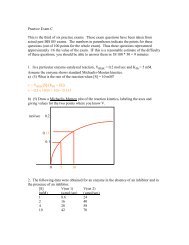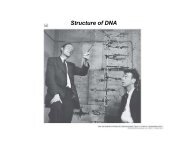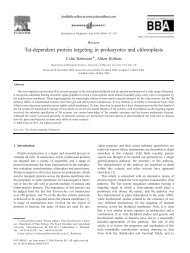The dual nature of homologous recombination in plants
The dual nature of homologous recombination in plants
The dual nature of homologous recombination in plants
- No tags were found...
Create successful ePaper yourself
Turn your PDF publications into a flip-book with our unique Google optimized e-Paper software.
Review TRENDS <strong>in</strong> Genetics Vol.21 No.3 March 2005 18132 Bennett, C.B. et al. (1993) Lethality <strong>in</strong>duced by a s<strong>in</strong>gle site-specificdouble-strand break <strong>in</strong> a dispensable yeast plasmid. Proc. Natl. Acad.Sci. U. S. A. 90, 5613–561733 Lieber, M.R. et al. (2003) Mechanism and regulation <strong>of</strong> human non<strong>homologous</strong>DNA end-jo<strong>in</strong><strong>in</strong>g. Nat. Rev. Mol. Cell Biol. 4, 712–72034 Mengiste, T. et al. (1999) An SMC-like prote<strong>in</strong> is required for efficient<strong>homologous</strong> <strong>recomb<strong>in</strong>ation</strong> <strong>in</strong> Arabidopsis. EMBO J. 18, 4505–451235 Takeda, S. et al. (2004) BRU1, a novel l<strong>in</strong>k between responses to DNAdamage and epigenetic gene silenc<strong>in</strong>g <strong>in</strong> Arabidopsis. Genes Dev. 18,782–79336 Onoda, F. et al. (2004) SMC6 is required for MMS-<strong>in</strong>duced <strong>in</strong>terchromosomaland sister chromatid <strong>recomb<strong>in</strong>ation</strong>s <strong>in</strong> Saccharomycescerevisiae. DNA Repair (Amst.) 3, 429–43937 Gorbunova, V. et al. (2000) A new hyperrecomb<strong>in</strong>ogenic mutant <strong>of</strong>Nicotiana tabacum. Plant J. 24, 601–61138 Gherbi, H. et al. (2001) Homologous <strong>recomb<strong>in</strong>ation</strong> <strong>in</strong> planta isstimulated <strong>in</strong> the absence <strong>of</strong> Rad50. EMBO Rep. 2, 287–29139 Heitzeberg, F. et al. (2004) <strong>The</strong> Rad17 homologue <strong>of</strong> Arabidopsis is<strong>in</strong>volved <strong>in</strong> the regulation <strong>of</strong> DNA damage repair and <strong>homologous</strong><strong>recomb<strong>in</strong>ation</strong>. Plant J. 38, 954–96840 Gallego, M.E. and White, C.I. (2001) RAD50 function is essential fortelomere ma<strong>in</strong>tenance <strong>in</strong> Arabidopsis. Proc. Natl. Acad. Sci. U. S. A.98, 1711–171641 Ries, G. et al. (2000) UV-damage-mediated <strong>in</strong>duction <strong>of</strong> <strong>homologous</strong><strong>recomb<strong>in</strong>ation</strong> <strong>in</strong> Arabidopsis is dependent on photosyntheticallyactive radiation. Proc. Natl. Acad. Sci. U. S. A. 97, 13425–1342942 Filkowski, J. et al. (2004) Systemic plant signal triggers genome<strong>in</strong>stability. Plant J. 38, 1–1143 Lucht, J.M. et al. (2002) Pathogen stress <strong>in</strong>creases somatic <strong>recomb<strong>in</strong>ation</strong>frequency <strong>in</strong> Arabidopsis. Nat. Genet. 30, 311–31444 Mol<strong>in</strong>ier, J. et al. (2004) SNM-dependent <strong>recomb<strong>in</strong>ation</strong>al repair <strong>of</strong>oxidatively <strong>in</strong>duced DNA damage <strong>in</strong> Arabidopsis thaliana. EMBORep. 5, 994–99945 Mol<strong>in</strong>ier, J. et al. Dynamic response <strong>of</strong> plant genome to ultravioletradiation and other genotoxic stresses. Mutat. Res. (<strong>in</strong> press)46 Mol<strong>in</strong>ier, J. et al. (2004) CENTRIN2 modulates <strong>homologous</strong> <strong>recomb<strong>in</strong>ation</strong>and nucleotide excision repair <strong>in</strong> Arabidopsis. Plant Cell 16,1633–164347 Fritsch, O. et al. (2004) <strong>The</strong> INO80 prote<strong>in</strong> controls <strong>homologous</strong><strong>recomb<strong>in</strong>ation</strong> <strong>in</strong> Arabidopsis thaliana. Mol. Cell 16, 479–48548 van Attikum, H. et al. (2004) Recruitment <strong>of</strong> the INO80 complex byH2A phosphorylation l<strong>in</strong>ks ATP-dependent chromat<strong>in</strong> remodell<strong>in</strong>gwith DNA double-strand break repair. Cell 119, 777–78849 McCl<strong>in</strong>tock, B. (1984) <strong>The</strong> significance <strong>of</strong> responses <strong>of</strong> the genome tochallenge. Science 226, 792–80150 Kovalchuk, I. et al. (1998) Transgenic <strong>plants</strong> are sensitive bio<strong>in</strong>dicators<strong>of</strong> nuclear pollution caused by the Chernobyl accident. Nat.Biotechnol. 16, 1054–105951 Kovalchuk, O. et al. (1999) Radiation hazard caused by the Chernobylaccident <strong>in</strong> <strong>in</strong>habited areas <strong>of</strong> Ukra<strong>in</strong>e can be monitored by transgenic<strong>plants</strong>. Mutat. Res. 446, 49–5552 Ries, G. et al. (2000) Elevated UV-B radiation reduces genome stability<strong>in</strong> <strong>plants</strong>. Nature 406, 98–10153 Kovalchuk, O. et al. (2001) A sensitive transgenic plant system todetect toxic <strong>in</strong>organic compounds <strong>in</strong> the environment. Nat. Biotechnol.19, 568–57254 Brakke, M.K. (1984) Mutations, the aberrant ratio phenomenon, andvirus <strong>in</strong>fection <strong>of</strong> maize. Annu. Rev. Phytopathol. 22, 77–9455 Kovalchuk, I. et al. (2003) Pathogen-<strong>in</strong>duced systemic plant signaltriggers DNA rearrangements. Nature 423, 760–76256 Leister, D. (2004) Tandem and segmental gene duplication and<strong>recomb<strong>in</strong>ation</strong> <strong>in</strong> the evolution <strong>of</strong> plant disease resistance gene.Trends Genet. 20, 116–12257 Ramakrishna, W. et al. (2002) Structural analysis <strong>of</strong> the maize rp1complex reveals numerous sites and unexpected mechanisms <strong>of</strong> localrearrangement. Plant Cell 14, 3213–322358 Richter, T.E. et al. (1995) New rust resistance specificities associatedwith <strong>recomb<strong>in</strong>ation</strong> <strong>in</strong> the Rp1 complex <strong>in</strong> maize. Genetics 141, 373–38159 Wulff, B.B. et al. (2004) Genetic variation at the tomato Cf-4/Cf-9 locus<strong>in</strong>duced by EMS mutagenesis and <strong>in</strong>tralocus <strong>recomb<strong>in</strong>ation</strong>. Genetics167, 459–47060 Kovalchuk, I. et al. (2000) Genome-wide variation <strong>of</strong> the somaticmutation frequency <strong>in</strong> transgenic <strong>plants</strong>. EMBO J. 19, 4431–443861 Reddy, K.C. and Villeneuve, A.M. (2004) C. elegans HIM-17 l<strong>in</strong>kschromat<strong>in</strong> modification and competence for <strong>in</strong>itiation <strong>of</strong> meiotic<strong>recomb<strong>in</strong>ation</strong>. Cell 118, 439–45262 Terada, R. et al. (2002) Efficient gene target<strong>in</strong>g by <strong>homologous</strong><strong>recomb<strong>in</strong>ation</strong> <strong>in</strong> rice. Nat. Biotechnol. 20, 1030–103463 Han<strong>in</strong>, M. et al. (2001) Gene target<strong>in</strong>g <strong>in</strong> Arabidopsis. Plant J. 28,671–67764 Iida, S. and Terada, R. (2004) A tale <strong>of</strong> two <strong>in</strong>tegrations, transgene andT-DNA: gene target<strong>in</strong>g by <strong>homologous</strong> <strong>recomb<strong>in</strong>ation</strong> <strong>in</strong> rice. Curr.Op<strong>in</strong>. Biotechnol. 15, 132–13865 Reiss, B. et al. (2000) RecA stimulates sister chromatid exchange andthe fidelity <strong>of</strong> double-strand break repair, but not gene target<strong>in</strong>g, <strong>in</strong><strong>plants</strong> transformed by Agrobacterium. Proc. Natl. Acad. Sci. U. S. A.97, 3358–336366 Jelesko, J.G. et al. (2004) Meiotic <strong>recomb<strong>in</strong>ation</strong> between paralogousRBCSB genes on sister chromatids <strong>of</strong> Arabidopsis thaliana. Genetics166, 947–95767 Jelesko, J.G. et al. (1999) Rare germ<strong>in</strong>al unequal cross<strong>in</strong>g-over lead<strong>in</strong>gto recomb<strong>in</strong>ant gene formation and gene duplication <strong>in</strong> Arabidopsisthaliana. Proc. Natl. Acad. Sci. U. S. A. 96, 10302–1030768 Christianson, M.L. (1975) Mitotic cross<strong>in</strong>g-over as an importantmechanism <strong>of</strong> floral sector<strong>in</strong>g <strong>in</strong> Tradescantia. Mutat. Res. 28, 389–39569 Burk, L.G. and Menser, H.A. (1964) A dom<strong>in</strong>ant aurea mutation <strong>in</strong>tobacco. Tob. Sci. 8, 101–10470 Mol<strong>in</strong>ier, J. et al. (2004) Interchromatid and <strong>in</strong>terhomolog <strong>recomb<strong>in</strong>ation</strong><strong>in</strong> Arabidopsis thaliana. Plant Cell 16, 342–35271 Haubold, B. et al. (2002) Recomb<strong>in</strong>ation and gene conversion <strong>in</strong> a 170-kbgenomic region <strong>of</strong> Arabidopsis thaliana. Genetics 161, 1269–127872 Culligan, K. et al. (2004) ATR regulates a G2-phase cell-cyclecheckpo<strong>in</strong>t <strong>in</strong> Arabidopsis thaliana. Plant Cell 16, 1091–110473 Dubest, S. et al. (2004) Roles <strong>of</strong> the AtErcc1 prote<strong>in</strong> <strong>in</strong> <strong>recomb<strong>in</strong>ation</strong>.Plant J. 39, 334–34274 Han<strong>in</strong>, M. et al. (2000) Elevated levels <strong>of</strong> <strong>in</strong>trachromosomal<strong>homologous</strong> <strong>recomb<strong>in</strong>ation</strong> <strong>in</strong> Arabidopsis overexpress<strong>in</strong>g the MIMgene. Plant J. 24, 183–18975 Liu, Z. et al. (2000) Repair <strong>of</strong> UV damage <strong>in</strong> <strong>plants</strong> by nucleotideexcision repair: Arabidopsis UVH1 DNA repair gene is a homolog <strong>of</strong>Saccharomyces cerevisiae Rad1. Plant J. 21, 519–52876 Gallego, F. et al. (2000) AtRAD1, a plant homologue <strong>of</strong> human andyeast nucleotide excision repair endonucleases, is <strong>in</strong>volved <strong>in</strong> darkrepair <strong>of</strong> UV damages and <strong>recomb<strong>in</strong>ation</strong>. Plant J. 21, 507–51877 Dubest, S. et al. (2002) Role <strong>of</strong> the AtRad1p endonuclease <strong>in</strong><strong>homologous</strong> <strong>recomb<strong>in</strong>ation</strong> <strong>in</strong> <strong>plants</strong>. EMBO Rep. 3, 1049–105478 Fidantsef, A.L. et al. (2000) <strong>The</strong> Arabidopsis UVH1 gene is a homolog<strong>of</strong> the yeast repair endonuclease RAD1. Plant Physiol. 124, 579–58679 Costa, R.M. et al. (2001) <strong>The</strong> participation <strong>of</strong> AtXPB1, the XPB/RAD25homologue gene from Arabidopsis thaliana, <strong>in</strong> DNA repair and plantdevelopment. Plant J. 28, 385–39580 Harlow, G.R. et al. (1994) Isolation <strong>of</strong> uvh1, an Arabidopsis mutanthypersensitive to ultraviolet light and ioniz<strong>in</strong>g radiation. Plant Cell 6,227–23581 Landry, L.G. et al. (1997) An Arabidopsis photolyase mutant ishypersensitive to ultraviolet-B radiation. Proc. Natl. Acad. Sci.U. S. A. 94, 328–33282 Filkowski, J. et al. (2004) Genome stability <strong>of</strong> vtc1, tt4, and tt5Arabidopsis thaliana mutants impaired <strong>in</strong> protection aga<strong>in</strong>st oxidativestress. Plant J. 38, 60–6983 Conkl<strong>in</strong>, P.L. et al. (1996) Environmental stress sensitivity <strong>of</strong> anascorbic acid-deficient Arabidopsis mutant. Proc. Natl. Acad. Sci.U. S. A. 93, 9970–997484 Li, J. et al. (1993) Arabidopsis flavonoid mutants are hypersensitive toUV-B irradiation. Plant Cell 5, 171–179www.sciencedirect.com








